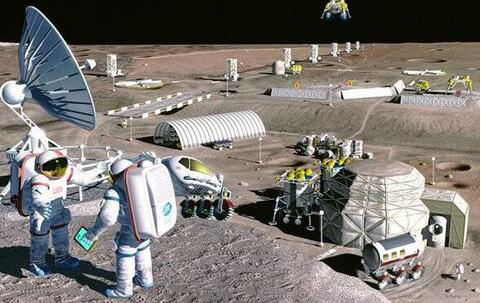


Scientists from European Space Agency imagine a futuristic lunar "village" on the Moon's surface. [Photo: people.com.cn]
The human race has long dreamed of living on the moon.
That dream, thanks to international collaboration and the latest scientific breakthroughs, is now a step closer.
Some scientists are imagining a futuristic lunar "village" on the Moon's surface, created using smart 3D-printing rovers, to create structures from the Moon's own natural sources.
Johann-Dietrich Woerner, who became the director general of the European Space Agency last July, believes that human beings will eventually live and work on the Moon.
His vision of a lunar settlement includes various space-faring nations, all living and working together.
"The Moon village, we would like to combine the capabilities of different space-faring nations, be it robotic or be it human, to look also for different activities, be it pure science, be it also business, even tourism, or mining or whatever, to put them together on the same place, and this is the idea of the Moon village."
Woerner sees a permanent lunar base as the next logical step, particularly following successful collaboration between space enabled countries on the International Space Station.
"The idea is that the different actors, the different players worldwide, they look in their special capabilities, and their special interests, and they bring just their small part into the idea. That means we can start with a small landing mission, which many countries are already planning, up to a huge investment for instance for some telescope, radio telescope, on the far side of the Moon. So it's multiple uses by multiple users, but a single place."
But how could you build such structures so far away from Earth?
One idea is to use the Moon's own natural resources to build and sustain a lunar base.
Roaming rovers could gather ice, metals and minerals to 3D print a structure or building.
A rover would land on the surface, inflate a dome, and then begin constructing a building to protect it and the astronauts inside.
Woerner hopes establishing a lunar base will allow experts to set up a radio telescope on the far side of the moon, shielded from radio pollution from Earth.
Astronauts could also be sent to the Moon's pole regions, where unmanned missions have previously found water ice.
He says as more nations make plans to return to the Moon, the need for a permanent base will grow.
"The first step is already done. The first step is that we are discussing it and there are several member states of ESA, but also outside ESA, which are interested in doing some missions to Moon. So we have also from ESA we have a cooperation together with the Russians for some Moon landing ideas. So, all of these now have to be in a further discussion process, come together. So it's started already. "
China has long advocated collaboration in space research, and a mission to the moon to collect samples is scheduled for later this year.
China is also well on the way to launching a manned space station into low Earth orbit in the coming years.
 Train rides through blossoms
Train rides through blossoms HD pictures of battleships of PLA Navy
HD pictures of battleships of PLA Navy East Sea Fleet conducts combat drills
East Sea Fleet conducts combat drills Sophie Marceau goes square dancing in Guangzhou
Sophie Marceau goes square dancing in Guangzhou Police officers learn Wing Chun in E. China
Police officers learn Wing Chun in E. China Charming models compete in super model contest in Beijing
Charming models compete in super model contest in Beijing Thai most beautiful transgender Nong Poy release new photos
Thai most beautiful transgender Nong Poy release new photos Now and then photos of Shanghai Jiaotong University
Now and then photos of Shanghai Jiaotong University Is this what air travel will look like in 2050?
Is this what air travel will look like in 2050? Top 20 hottest women in the world in 2014
Top 20 hottest women in the world in 2014 Top 10 hardest languages to learn
Top 10 hardest languages to learn 10 Chinese female stars with most beautiful faces
10 Chinese female stars with most beautiful faces China’s Top 10 Unique Bridges, Highways and Roads
China’s Top 10 Unique Bridges, Highways and Roads Two Czechs describe how their love of China has lasted decades
Two Czechs describe how their love of China has lasted decades  Su Bin deserves respect whether guilty or innocent
Su Bin deserves respect whether guilty or innocent  US and China cooperate on largest nuclear security center in Asia-Pacific
US and China cooperate on largest nuclear security center in Asia-Pacific  Longer hours, differences in office culture and time zones trigger burnout among foreigners working in China
Longer hours, differences in office culture and time zones trigger burnout among foreigners working in China Day|Week